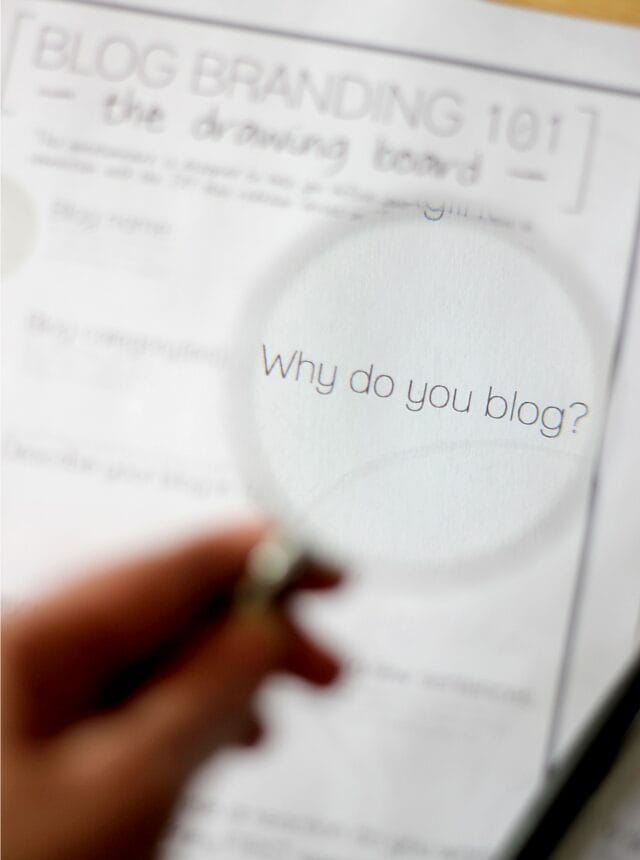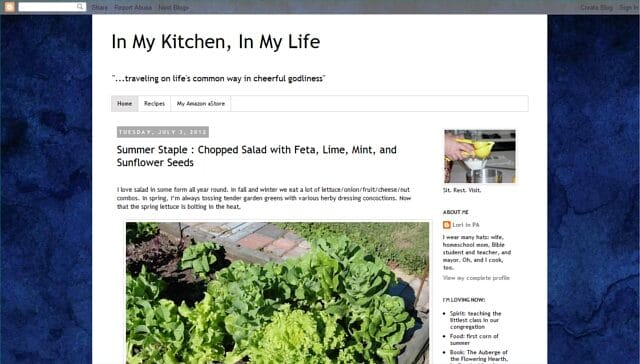I’m soooo excited! This is the beginning of the DIY blog design makeover series (which I’ve really been looking forward to!) where I’ll be taking one person’s blog and doing a 10-part complete redesign, makeover and transfer to WordPress — and giving tutorials and tips, as a graphic designer, on how to do your own blog makeover as well. I hope that any of you who are bloggers as well will find it helpful- at the end of this post there is a free printable worksheet, as pictured above, which I have made to help you start down this road. And I have to say I am very excited about the project myself – this type of thing is my cup of tea!
So that you know what to expect, in today’s post here is what we’ll cover:
– introducing the blog I will be redesigning
– meat and potatoes vs. garnish and plating
– what branding is
– my free Branding 101 printable and tips on how to use it to establish your own branding.
‣ ‣ ‣ Meet Lori
The lovely blog I’ll be reworking is by a reader and dear friend of mine, Lori, and it is called “In My Kitchen, In My Life“. I’ve known Lori for years- she taught me Bible classes as a child, cooking classes in high school, and has been a great source for advice now that I am a married woman – and I’m tickled to get to work on her design. Her blog is perfect for this type of makeover, because she has a distinct voice in her posts, and writes highly valuable content for her audience (I definitely recommend checking it out!) – but her blog’s design, while not bad, could be doing a lot more to highlight her content and give her better features, which is why she volunteered for me to use her blog. Here is a screen shot of her blog as it is currently:
‣ ‣ ‣ Meat and potatoes vs. plating and garnish
Lori’s blog is an excellent example of having what’s really important in a blog: great content. The content of your posts is the core and essence of your blog. It’s the meat and potatoes, the entree. The design, on the other hand, is the plating and the garnish. You can have the most beautiful plating and garnish – but if the real substance of the food is missing, the plating and garnish won’t make up for that. However, once you do have the meat and potatoes, the plating and garnish can make a big difference in the presentation and how your content is received. A delicious meal can be a delicious meal even on a paper plate – but it can also be taken up to the next level by being served on beautiful plating with tasteful garnishing. As they say, “content is king” and we will be addressing content somewhat in this series, but largely it will be about taking the great content you have, like Lori does on her blog, and presenting it in the best possible light – adding that next level of plating and garnish.

‣ ‣ ‣ What is branding?
(And do I need it, even if my blog is not a business?)
So we’re going to be starting at the “drawing board”: establishing your blog’s branding, which personally I find can be a really fun project. Now, you may think of branding as just being connected to businesses and shops and so forth, and your blog may or may not be a business blog. Or, like I used to think, you might think that branding just means a logo. But the concept of branding can certainly apply to blogs whether they are businesses or not, and is much broader than a logo. Blog branding is the unique style and experience that your readers will have and see in all aspects of what you are offering. Here is one way to see branding in general … imagine you are at the mall and are planning to buy a white t-shirt there. You could buy a white t-shirt at any number of places in the mall – but it’s going to be a different person who chooses to buy the shirt from Coldwater Creek as opposed to American Eagle, or from Hot Topic – and this is because even though the white t-shirts might not vary that greatly, the branding extends beyond just the simple items themselves, but covers the entire experience from going there, to buying the item, to how you feel about the item – and those different types of branding appeal to different people. The same is true for your blog. Your blog branding covers the entire experience of someone coming on your site, not just the content itself, and applies whether you have a business blog or not, because even if you’re not selling anything, you’re still trying to win the eye of your target readership. The branding you want to have on your blog will impact all of your design choices in a makeover, and branding will vary widely from blog to blog depending on why you are blogging, your target audience, and your own style and personality. So to start out this series I’ve made a branding questionnaire printable to help walk you through how to narrow down to what you want that branding on your blog to be.

‣ ‣ ‣ Branding 101 Printable & How-To Tips
As we move forward in this series (which will continue here on Fridays) a lot of the things we will be doing in future posts will be based on the answers you give to questions on this printable. I sent these questions to Lori ahead of time so that I could base her blog’s design on her answers. These questions don’t really require very long answers, and for the most part are pretty straightforward, but there are a few that I wanted to give some additional explanation for here.

The first section is just the basics, and things that you probably already have established: your blog name, tagline, etc. One question on there, though, that I want to point out is “Why do you blog?” You don’t really need to get very deep on this answer unless you want to – this is largely to establish the purpose for your blog. Is it to promote your business? Is it to offer advice or support on a certain topic? Is it to get feedback on your writing skills? The one answer I would avoid putting here is anything along the lines of “for fun” or “for a creative outlet”, because that doesn’t shed any light on why you are writing on a publicly viewable website as opposed to a personal journal at home. This question has to do with why you a seeking an audience for your writing – you want to be upfront with your audience with what they can expect. If it’s a business related blog, you want to make that clear in your design so your readers aren’t taken aback or surprised when you start talking about selling to them. Or if you are wanting build a online support community with your blog, you want make sure your design offers easy ways to join and participate. And so forth, depending on why you are blogging.

The rest of the questions of the 2-page printable are what I call “The Brass Tacks”. They are questions to help you think through and define what kind of style and look you want to go for on your blog, and help lead up to the last question: to come up with a branding and design statement. What is a branding and design statement, you ask? It is not a tagline or something that describes your blog to other people, it is simply a succinct phrase that describes the feel you want in your branding and design, for your own use as a guideline while you design your blog. It doesn’t have to make a lot of sense to other people, as long as it is crystal clear in your own mind – but it should be short. As an example, my own branding statement that encompasses all of my sites (my blog, my shop, my website, etc.) is “cozy urban cafe”. That may or may not make perfect sense to you as you look at my sites – for instance, urban style can mean a more hip-hop and grafitti type style, but I mean it more in a downtown kind of way – but in my own mind it is clear, and as a result, all of my sites have a similar feel that reflects my original design goals.
If you’re easily able to answer the questions asking for just a couple specific style terms and such, you’ll probably have a fairly easy time coming up with your branding statement. But if, as you’re trying to answer the style and adjective questions, you can’t think of how to describe it, try imagining your blog was an actual physical location, like a shop or a house, and see if that helps you describe the look you want. Even then, though, it may feel a little nebulous or scattered. In helping people with blog design in the past, I think this is one of the things that people have a lot of trouble with – defining exactly what they want on their blog. When Lori gave me her answers, they were a little more general than the questions asked for, which I was actually glad to see, because I think this is common issue and gave me the opportunity to demonstrate (since I’m the one doing the designing in this case) on how to take these general types of ideas and narrow down to a branding and design statement.

Here were Lori’s answers to the two questions that asked for a few style terms and adjectives:
“This is where I just get overwhelmed. Is there such a thing as the modern side of Lands’ End clothing meets Italian Renaissance art meets old books meets straw garden hat and good hand tools meets artful cheese plate? That’s my style. Good luck.”
“Ai, yai, yai… Pick for me, please! Ok, one of those great looking rooms where the furniture is very comfy, very functional, with few useless objects except a very few of sentimental value which are also lovely to look at — like my pottery bowl of river rocks picked up from a Swiss alpine stream and my basket of postcards from our travels and field trips.”
Her answers really made me smile – I think this feeling of “this-meets-this-meets-this … what is that?” is very common. So, if you’re in this boat, know you’re not alone! I can understand why it seems overwhelming – it would be very difficult to design anything trying to juggle all these different aspects. But here is what I did to filter Lori’s description down to a single style description, and I hope you’ll find the process can be fun, not daunting.
The first step is that you want to think about what the different aspects have in common – what ties them together. Personally, I went and found pictures of the things she mentioned in her description … a piece of Italian Renaissance art, some old books, hand tools, artisinal cheese plate, etc., and lined them all up to be able to make some visual comparisons. Another way to look at this came up as I was explaining to Tim the process of narrowing down to the similarities; a light bulb turned on in his head and he said, “Yeah, it’s like finding the common denominator of the different styles!”, and he started kind of mind-mapping attributes of the different items to find common ground. I thought that was a interesting way to think of it – especially if you’re more of an abstract/math brained person like Tim. Or the visual comparison might work better for you if you are more artsy-brained, like me. But in whatever method works best for you, try to think of what the common cord is that ties the different elements together.
Secondly, you might think I’m going to say find what is different between the elements- but that’s not quite the case. It would be a pretty endless list! Instead, ask yourself, “How do these things comment on each other?” In other words, why didn’t Lori answer with JUST the Italian Renaissance for her look? What is it about garden tools that fills something that was missing in the Italian Renaissance? What is it about Lands’ End that fills a style need missing in having old books alone? Contrast to try to find how and why these different pieces comment on each other. You may find that some aspects are actually very overlapping, where as some introduce a whole missing, but vital, piece of the puzzle.
After going through this process, here is the design statement I came up with from Lori’s description:
“Classic and cultured, done simply and down to earth.”
I feel that encompasses what she was trying to portray in her descriptions. Now the last (but very important)
step in crafting your design statement is this: once you have your design statement, forget about all those nebulous descriptions. Now, I don’t mean forget about the other questions you answered on the printable, we’ll still be using a lot of those answers in the future. But those fuzzy nebulous thoughts of Renaissance-meets-cheese-plate-meets-gardening-tools — let those go. You want to design and plan you blog look based on your branding statement. If you try to design with all of those other things in mind, you’re going to end up with some parts of your blog looking like the Renaissance, and some parts looking like garden tools, but it’s not going to all tie together. Your branding statement should encompass everything you need from those nebulous thoughts, anyway. If you feel you can’t let go of those because it feels like something will be missing, then that is probably a sign that your branding statement is not complete. Once you have a branding statement finished, it will make your job of designing SO much easier in the rest of the process.
I hope this has been helpful! You can get the free printable by clicking the photo, below.
Let me know how it goes answering these questions – and if you are having trouble narrowing down to a design statement, talk about it in the comments below, and let’s see if we can help each other out! 🙂
Please leave your thoughts and comments below – I love to hear from you!
You can check out the rest of the posts in the series here:
Part 1: Discover your branding with “The Drawing Board” Printable (That is today’s post!)
Part 2: WordPress vs. Blogger
Part 3: Design Tips + Design Worksheet
Part 4: Themes, Coding and Stylesheets
Part 5: Making your own graphics
Part 6: 7 Blog Layout Tips to Engage your Reader
Part 7: Blog Page: The Must-haves and the Panache
Part 8: 25 WordPress Tips
Part 9: The Big Reveal
Part 10: 7 Ways to Promote and Market Your Blog




